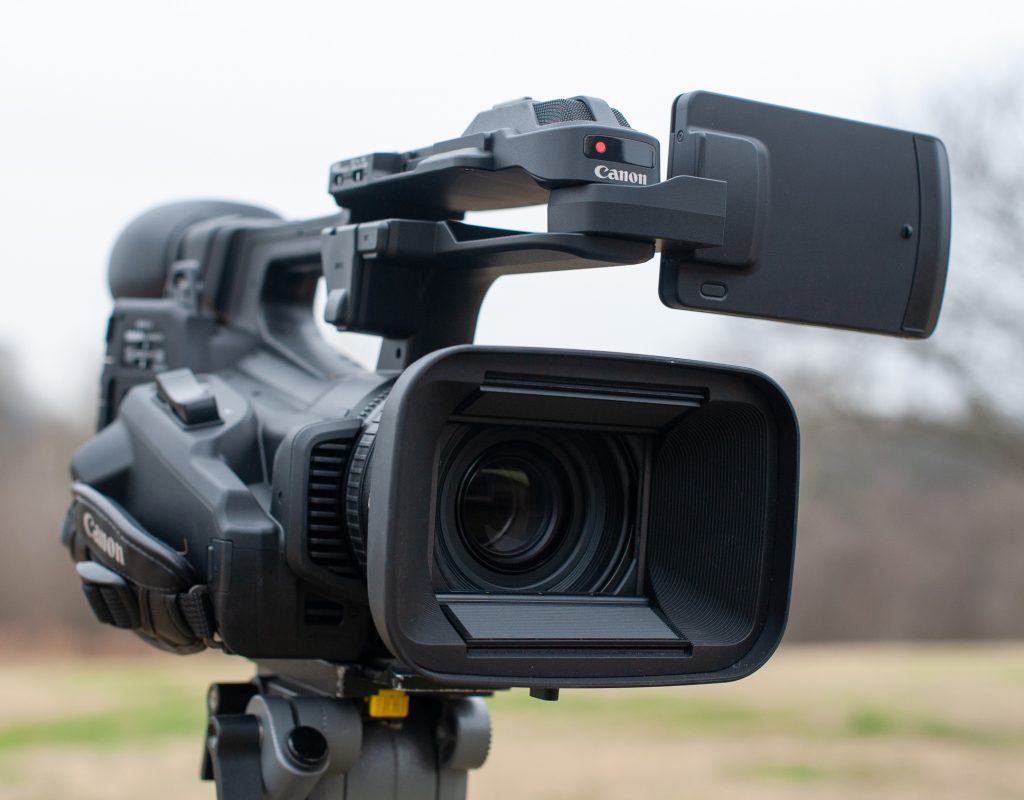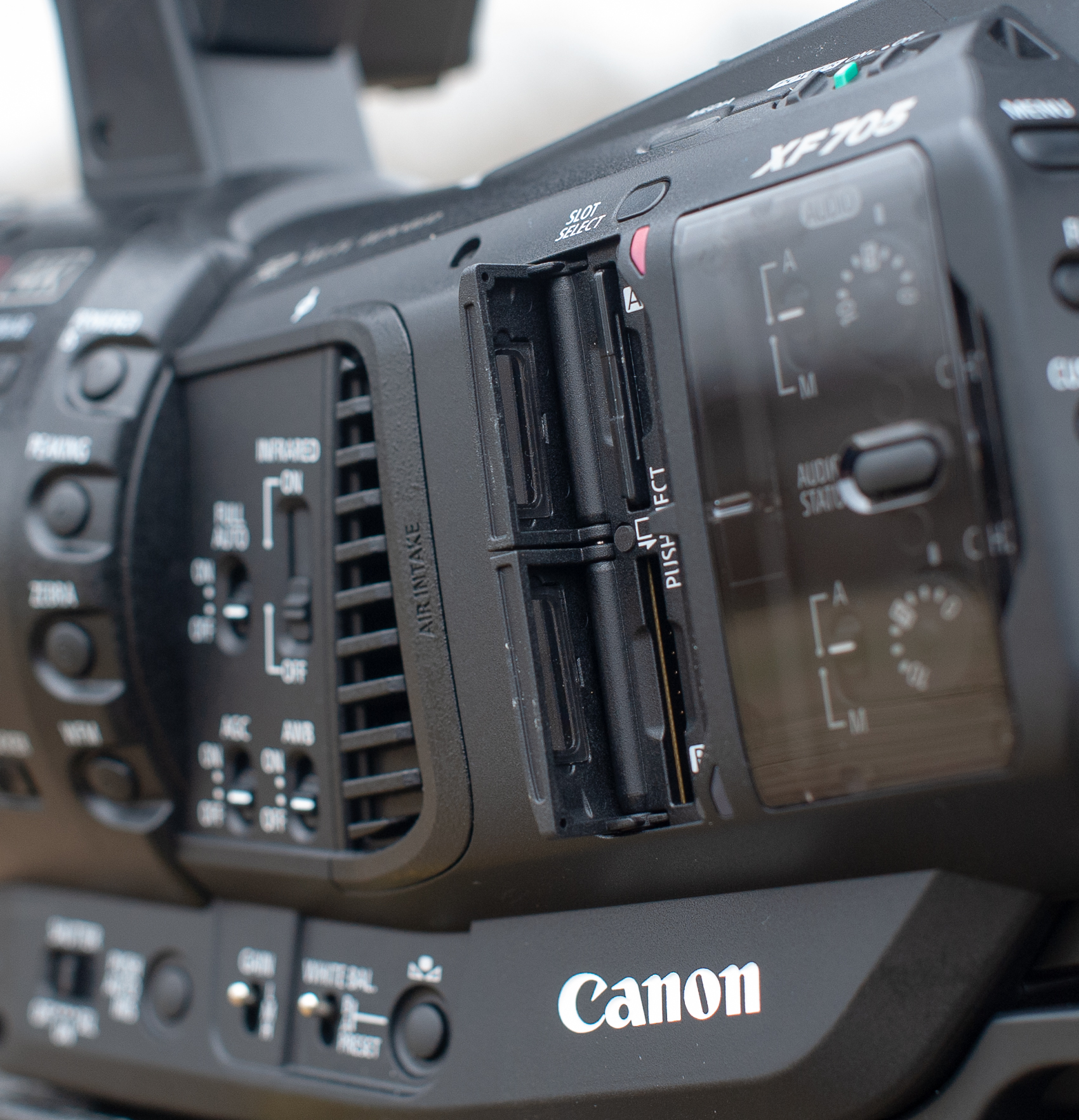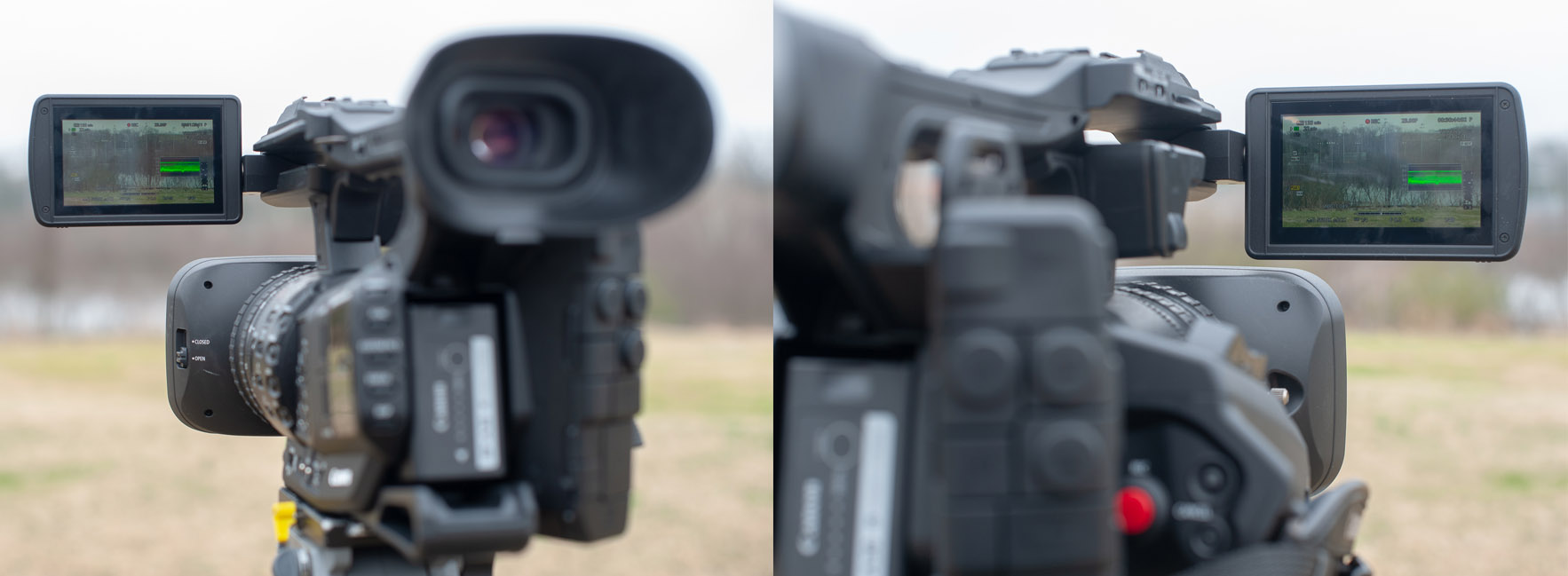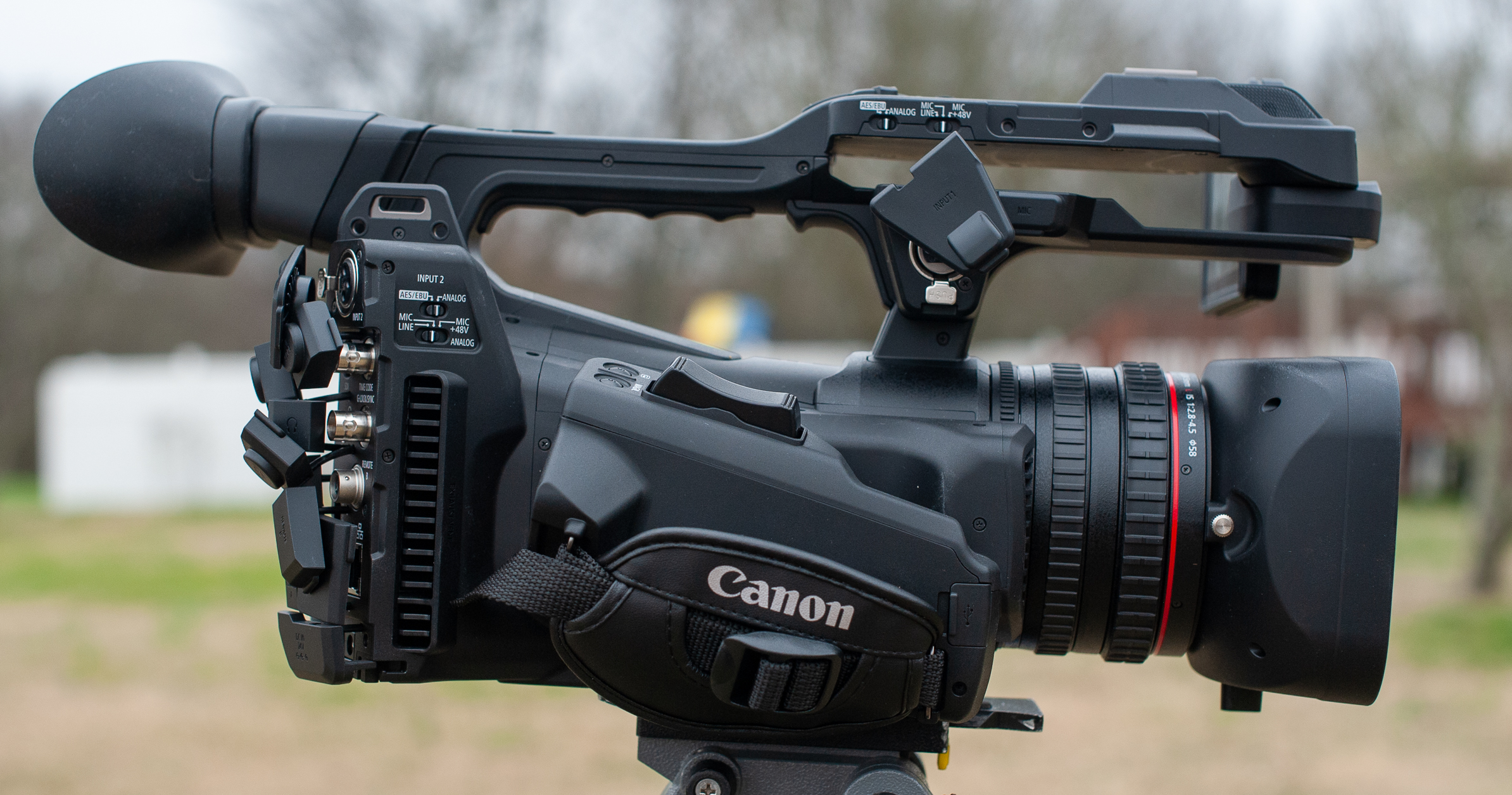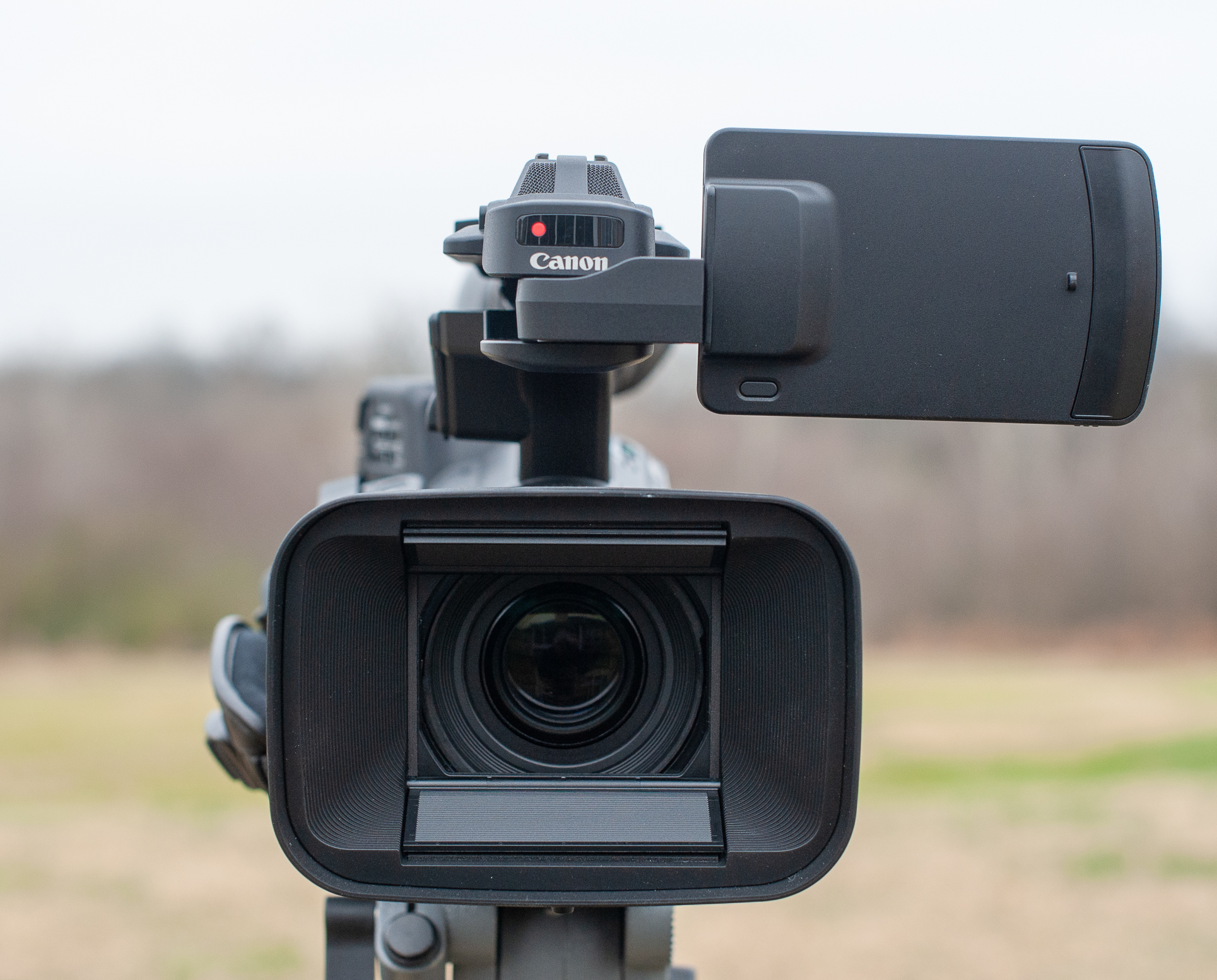The Canon XF705 is the flagship XF camcorder for Canon and it deserves the placement admirably. The 1″ sensor XF-HEVC H.265 Pro Camcorder packs an Ultra High Definition sensor with the kind of rich color shooters expect from Canon cameras. The XF705 is packed full of useful features for any shooter. Standouts are Canon’s great Dual-Pixel CMOS Autofocus feature, the color, and many others which I will dive into shortly. Does the Canon XF705 have weaknesses? All cameras do, but how about we look at some example of footage first.
Canon XF705
The Canon XF705 has a 1.0″ type CMOS sensor with a DIGIC DV6 processing all the camera’s UHD footage. The Canon C200 has the same image processor. The camera is equipped with a fixed 15x optical zoom with an f/2.8 aperture, though this is not constant and f-stop changes from f/2.8 to f/4.5 depending on the focal length. The lens has three manual control rings for iris, focus, and zoom, all with end stops. If you have ever used a manual lens before then the lens on the XF705 will feel at home in your hands.
Ease of Use
Is the Canon XF705 easy to use? This is an important feature for me because a camera needs to be out of a shooter’s head when they are chasing down those fleeting moments that often happen during a run and gun shoot. Essentially, are the right buttons in the right place. For the most part, the Canon XF705’s buttons to settings are where one expects them to be on a single-lens camcorder, nearly all on the left side of the camera body. The gain, white balance, and ND filters are right where one expects. The rest of the buttons need to be used a few times for the brain to gain muscle memory of their placement.
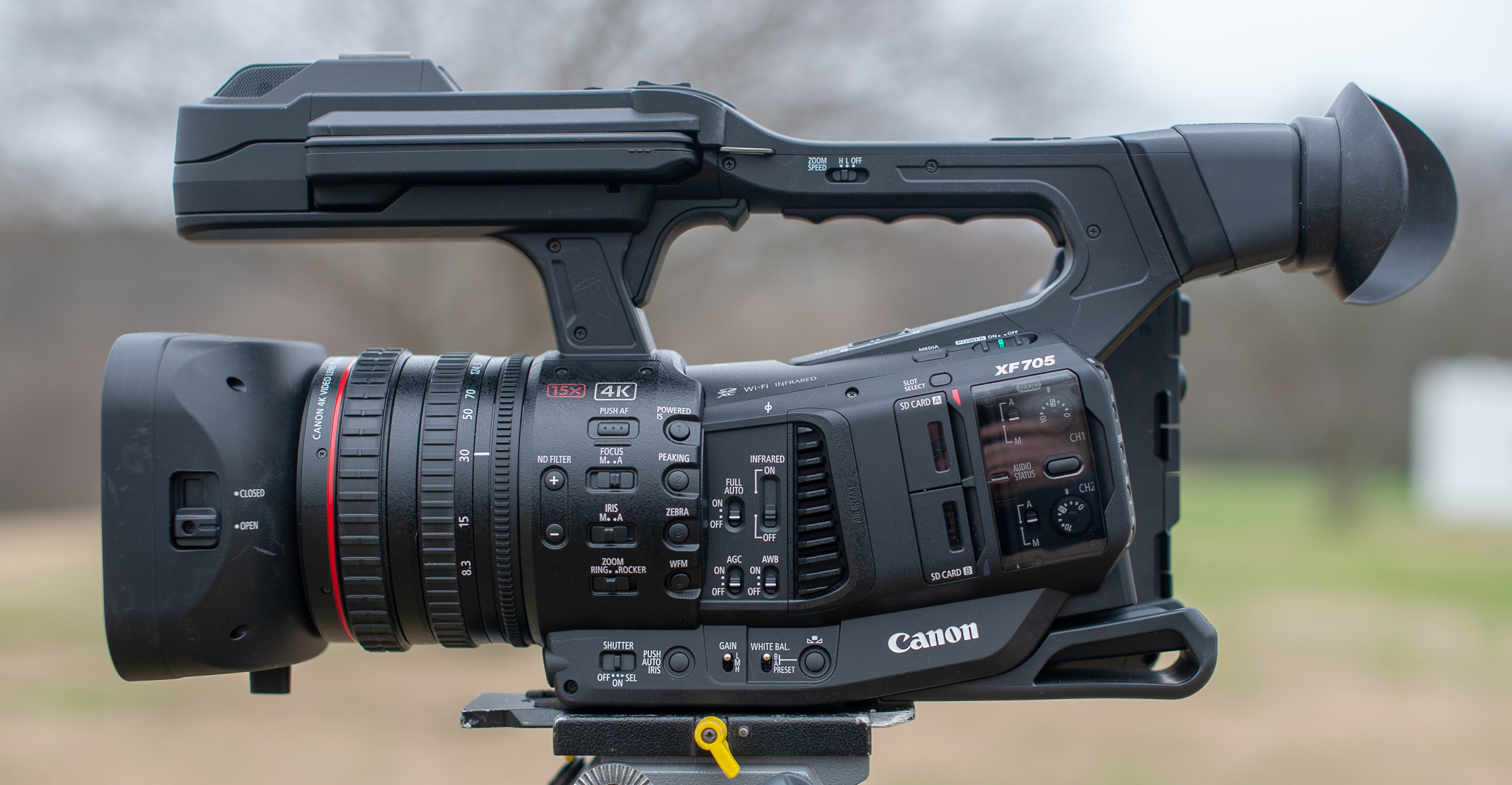 Otherwise, there is really only one setting I found a little frustrating. The gain button on the side of the camera has three settings. These three gain settings can be pre-selected in the XF705’s menu. If you want to vary away from these three pre-selected gain settings then a shooter will need to use the Function button on the back of the camera to change the camera’s gain. I found changing the gain via function button a little slow for my liking. Bear in mind, I shoot a ton of run and gun and I expect a camera to be easy to use very quickly. I just am not a fan of stopping to change my gain. I think it might be nice if the gain setting on the side of the camera could be just an up gain or down gain button. Then a shooter can scale up or down the camera’s exposure quickly.
Otherwise, there is really only one setting I found a little frustrating. The gain button on the side of the camera has three settings. These three gain settings can be pre-selected in the XF705’s menu. If you want to vary away from these three pre-selected gain settings then a shooter will need to use the Function button on the back of the camera to change the camera’s gain. I found changing the gain via function button a little slow for my liking. Bear in mind, I shoot a ton of run and gun and I expect a camera to be easy to use very quickly. I just am not a fan of stopping to change my gain. I think it might be nice if the gain setting on the side of the camera could be just an up gain or down gain button. Then a shooter can scale up or down the camera’s exposure quickly.
Canon Color and Canon LOG 3
The XF705 can shoot in a few different profiles. For example, the camera can shoot at Rec 709, Rec 2020, and Canon Log 3. I used the Canon XF705 almost exclusively in Rec. 2020 or Canon Log 3. Canon Log 3 is a gamma setting designed for easier color grading and to make noise less noticeable. I find Canon Log 3 to be effective for color grading and dialing in a look. Now, if you are going to go out and shoot a log picture only to place Canon’s LUT on it and call it a day during your edit. Maybe you should just shoot Rec 709 or Rec 2020. It might make your life easier in the long run.
Ultra High-Definition Footage
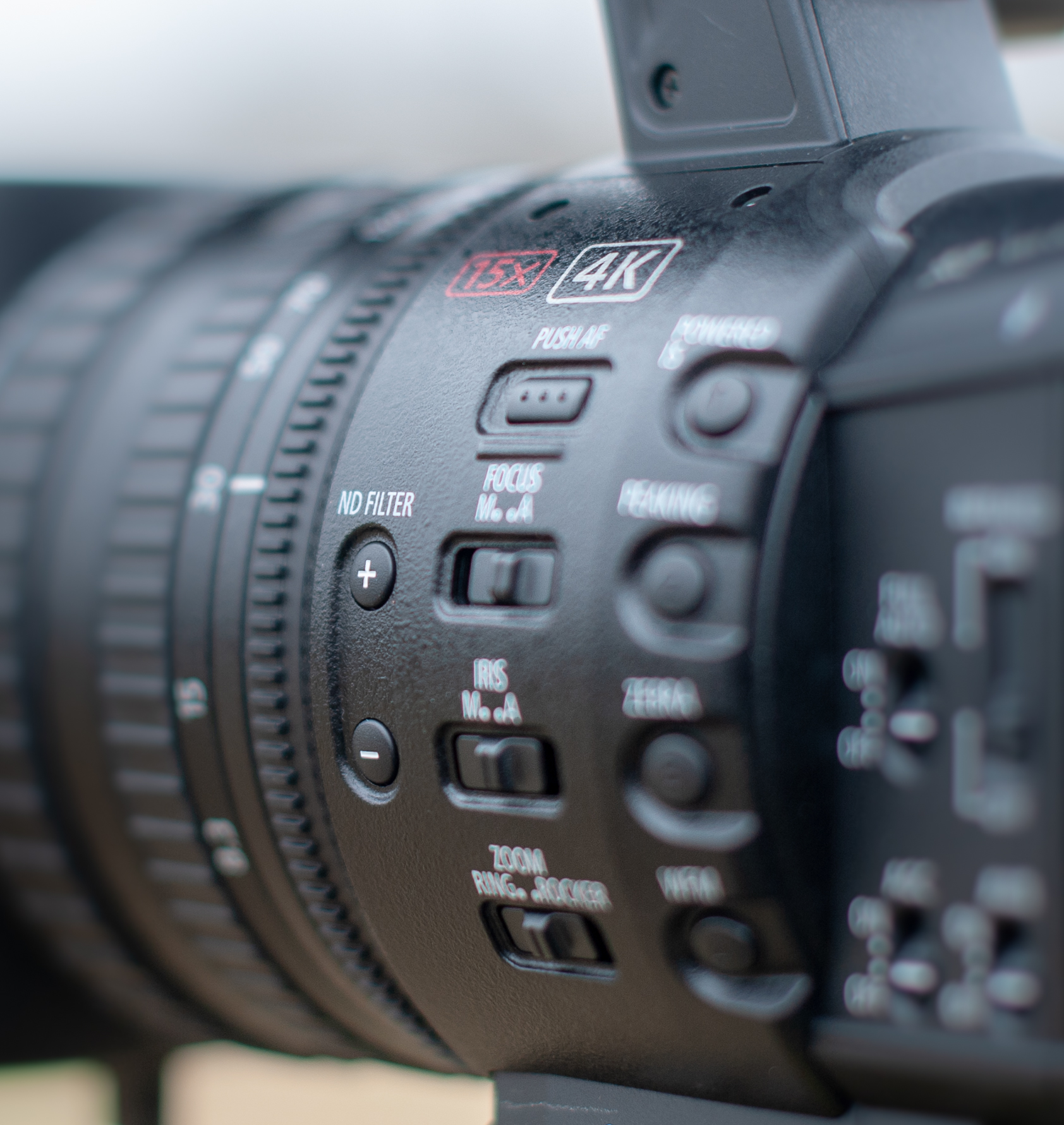 If you want to shoot Log on a camera then Nashville, Tennessee has the weather for you. We were covered in gray skies with foggy mornings for most of December and the rest of winter. Shooting Log footage in this weather just makes the video look even more… well, log. Though the fog was pretty. I found the XF705 delivered great looking Ultra High-Definition footage. The UHD footage had enough of a sharpness to it to make shooting nice wide shots and keeping them crisp looking even in foggy weather. When I brought the camera inside to shoot more footage I found the Canon XF705 delivered good looking skin tones and handled mixed lighting well. I think users will be pleased with how their footage will look as long as they are into the depth of field a 1″ camera delivers. Just do not expect Canon C700 Full-Frame quality color. I mean this just is not that kind of camera.
If you want to shoot Log on a camera then Nashville, Tennessee has the weather for you. We were covered in gray skies with foggy mornings for most of December and the rest of winter. Shooting Log footage in this weather just makes the video look even more… well, log. Though the fog was pretty. I found the XF705 delivered great looking Ultra High-Definition footage. The UHD footage had enough of a sharpness to it to make shooting nice wide shots and keeping them crisp looking even in foggy weather. When I brought the camera inside to shoot more footage I found the Canon XF705 delivered good looking skin tones and handled mixed lighting well. I think users will be pleased with how their footage will look as long as they are into the depth of field a 1″ camera delivers. Just do not expect Canon C700 Full-Frame quality color. I mean this just is not that kind of camera.
While this camera has the choice to increase its gain setting to +33 I really think one should shy away from topping out this camera. At the highest setting you get what you expect, a soft image, increased noise, and general mud. If anything, I suggest steering this camera away from settings with very little light.
XF-HEC Codec
Canon has introduced a new codec for the XF705. The new XF-HEVC codec uses HEVC encoding which is about twice as efficient as H.264/AVC. With the XF-HEVC the XF705 can 4K UHD 60P 4:2:2 10-bit files directly to widely available SD cards. I am not about to dive into the mathematical details why XF-HEVC is lighter than H.264 because I am not that smart. My father is the one with a mathematics degree, not me. What is important is the size of the XF-HEVC files are more than manageable for UHD footage. Less space required is always a blessing as long as it does not reduce image quality. Canon seems to have achieved this goal. For those of you with older edit systems, the new codec might make your computer a little sluggish. Editing UHD footage in the XF-HEVC codec nearly brought my older MacBook Pro to a stop.
Dual SD Card Slots
Relay recording or dual recording. These are your choices on the Canon XF705. Having a camera with dual SD card slots and relay recording is great for those long interview shoots. There is no reason to sweat as you interview a long-winded subject. For those who shoot critical once-in-a-lifetime events, like a wedding, then using the option to simultaneously record onto two SD cards is a great way to create a backup.
LCD Display
The 4-inch touchscreen LCD display on the Canon XF705 has the option to be used on either the left side of the camera, this is the standard side for a camera’s display, or the display can be used on the right side. I appreciate this detail Canon has put into the XF705. I see the XF705 as a solo-operator camera and having a display which can be used on both sides of the camera offers those solo-operators’ the option to frame interviews on the right and the left side of the frame since the operator can monitor from both sides on their camera. This is a small detail but crucial for videos where multiple subjects sit down for an interview.
The only other way to achieve this is to have an external monitor mounted either on the XF705 or near the camera. Both of those options can greatly weigh down the gear of a solo-operator who is already carrying, or wheeling, all of their gear themselves. How does the display and it’s 180-degree swivel feel in one’s hand? To me, I might take a lot of care with the display because the swivel joint does feel like hard abuse could damage it and cause problems down the line. I suggest operators to always stow the display away before carrying the camera around or in a bag.
Electronic Viewfinder
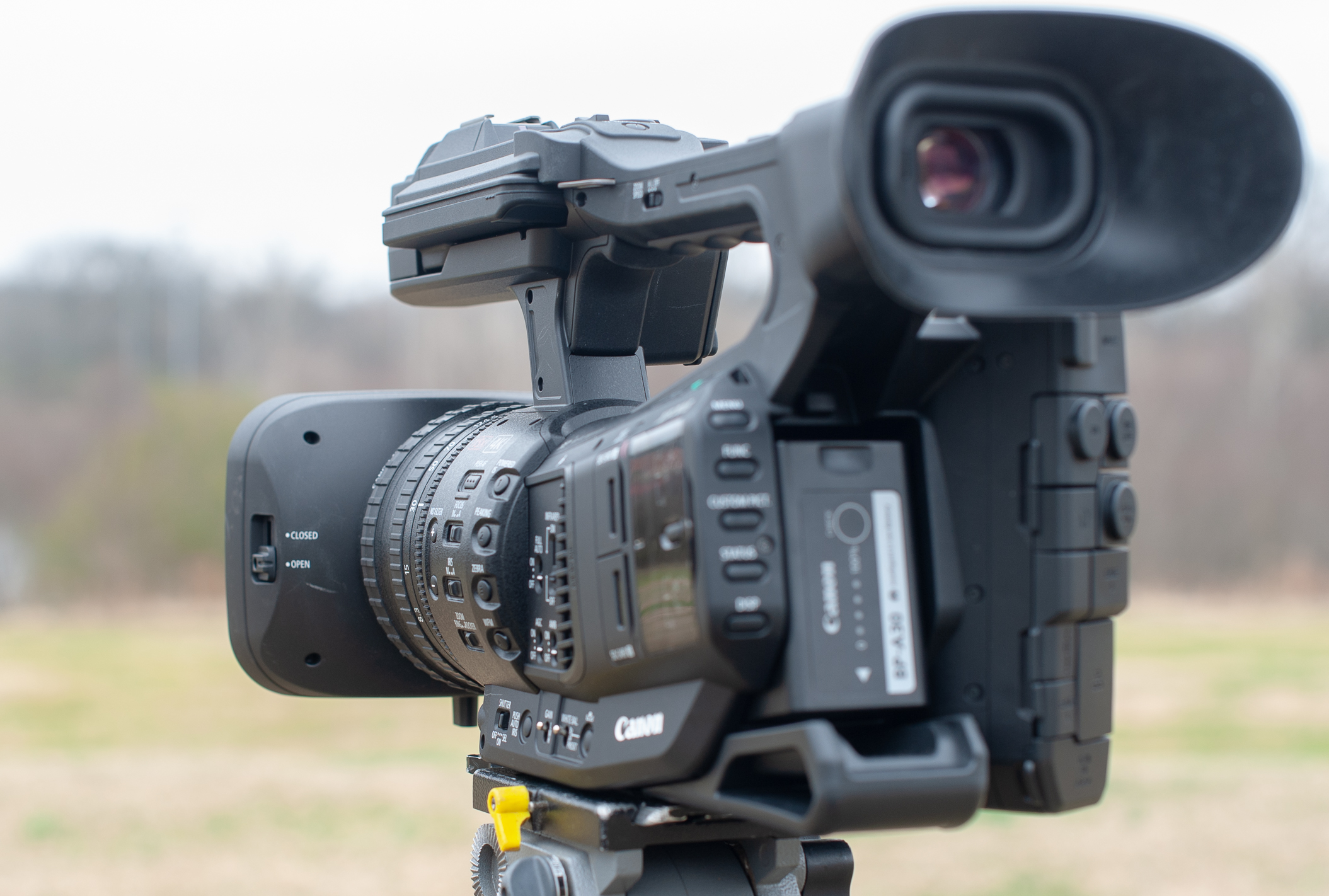 One thing I love about EVF’s on single-lens camcorders is the diopter is strong enough for me to use the EVF without my glasses. FYI I have horribly thick coke-bottle glasses. Do I need to go without my glasses to shoot on the Canon XF705? No, I don’t. The included eye cup more than covers my glasses for a light pollution free viewing. The 0.46″ OLED EVF is good. Make no mistake, it is small and on the rear of the camera, but Canon has made it about as good as a small EVF can be for a single-lens camcorder. Both the Display and EVF have all the necessary features for easy shooting: focus assist, Waveform monitor, 2 x focus punch in, and other useful camera information. What I am not a fan of is all of these features overlaying the image. I much prefer this information to be on the sides of my image, but I expect this might be difficult with the size of the EVF and Display.
One thing I love about EVF’s on single-lens camcorders is the diopter is strong enough for me to use the EVF without my glasses. FYI I have horribly thick coke-bottle glasses. Do I need to go without my glasses to shoot on the Canon XF705? No, I don’t. The included eye cup more than covers my glasses for a light pollution free viewing. The 0.46″ OLED EVF is good. Make no mistake, it is small and on the rear of the camera, but Canon has made it about as good as a small EVF can be for a single-lens camcorder. Both the Display and EVF have all the necessary features for easy shooting: focus assist, Waveform monitor, 2 x focus punch in, and other useful camera information. What I am not a fan of is all of these features overlaying the image. I much prefer this information to be on the sides of my image, but I expect this might be difficult with the size of the EVF and Display.
Dual-Pixel CMOS Autofocus
I kind of want to see Canon’s Dual-Pixel CMOS Autofocus in every single damn Canon Camera. Thankfully, the Canon XF705 has Dual Pixel CMOS Autofocus. This is the same autofocus found in the C100 Mark II, C200, C300 Mark II, C700 (EF Mount only), C700 FF (EF Mount only), and the newly announced EOS R. The XF705 Dual Pixel CMOS Autofocus has a touchscreen focus control via the display, Face Detection AF and object tracking. The Dual Pixel CMOS Autofocus also shows a shooter to see, graphically, if their manual focusing is in focus or not. The system also shows a shooter if their focus is forward or behind the subject.
Price and availability
The Canon XF705 is currently priced at $6,999 on FILMTOOLS.COM and the camera is currently in stock.
Overall thoughts
The XF705 is a strong camera in the single-lens camcorder arena. 4K 60p recording capabilities onto a standard SD Cards is a wholly unexpected feature and one to push the rest of the market forward. While the settings buttons may require a little time to get used to I think an operator who uses the XF705 will become accustomed to relatively quickly. Be careful with the display and this camera will last awhile.
XF705 Product Highlights
- 1″ CMOS Sensor, 13.4MP
- UHD 4K up to 60 fps, 1080p to 120 fps
- H.265/HEVC Codec, 4:2:2 10-bit Color
- 15x Optical Zoom, 30x Digital
- Focal Length 8.3 to 124.5mm
- 35mm Equivalent Focal Length 25.5 to 382.5mm
- Filter Size – 58mm
- Control Rings – Focus, Zoom, and Iris
- Optical Image Stabilization
- Digital Image Stabilization
- Built-In ND Filter – Mechanical 2 stop, 4 stop, and 6 stop filters
- Dual-Pixel CMOS Autofocus Feature
- HDR Recording, Canon Log 3, Wide DR
- 12G-SDI and HDMI Outputs
- Dual XLR Inputs, 4-Channel LPCM Audio
- 2 x SDXC Memory Card Slots
- H.265 4:2:2 10-Bit:
- 3840 x 2160p at 23.98/29.97/59.94 fps (160 Mb/s)
- 3850 x 2160p at 23.98/29.97/59.94 fps (110Mb/s)
- 1920 x 1080p at 23.98/29.97/59.94 fps (60 Mb/s)
- 1920 x 1080p at 23.98/29.97/59.94 fps (45 Mb/s)
- 1920 x 1080i at 59.94 fps (60 Mb/s)
- 1920 x 1080i at 59.94 fps (45 Mb/s)
- 1920 x 1080p at 120 fps (180 Mb/s)
- H.264 4:2:0 8-Bit:
- 1920 x 1080p at 23.98/29.97/59.94 fps (45 Mb/s)
- IP Steaming
- MPEG2: 1920 x 1080 to 3840 x 2160 at 25p, 29.97p, 50p, 59.94p (4.0 to 16.00 Mb/s)
- MPEG2: 1920 x 1080 to 1920 x 1080 at 50i, 59.94i (4.0 to 9.0 Mb/s)

Filmtools
Filmmakers go-to destination for pre-production, production & post production equipment!
Shop Now